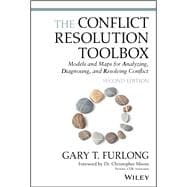Learn to effectively resolve conflict the way that works best for you
When it comes to real-world conflict resolution, one size does not fit all. In the professional world especially, it’s critical for individuals to be prepared for a variety of situations and to know what tools and techniques can be used to settle disputes and disagreements in a way that is respectful of both party’s needs. The Conflict Resolution Toolbox shows mediators, negotiators, managers, and professionals at all levels how to simply and effectively assess conflict situations and choose the right tools to resolve the issue in a meaningful way.
- Understand the why behind the conflict and how it can be resolved
- Recognize the unconscious judgements and biases that are obstacles to conflict resolution
- View conflict situations objectively and from multiple viewpoints
- Learn how the latest neuroscience and behavioral economics research plays a role in conflict resolution
With over 25 years of experience in mediation, negotiation, and conflict resolution, author Gary T. Furlong brings to light the intrinsic habits and interpretations that can unwittingly surface and lead to further tension during times of conflict and unrest. This timely update to The Conflict Resolution Toolbox marries theory and practice and is a hands-on guide to understanding the root of conflict and selecting the simple strategies for addressing specific scenarios that individuals routinely face in the workplace and in life.
Conflict may be unavoidable, but resolution is within reach with the invaluable guidance and techniques found in The Conflict Resolution Toolbox.








